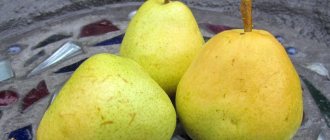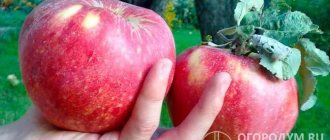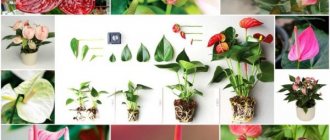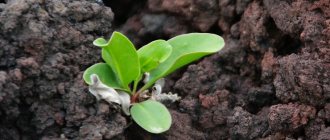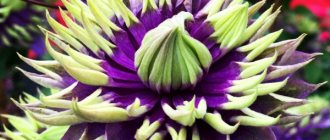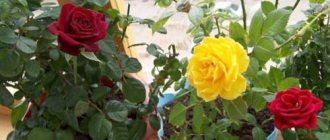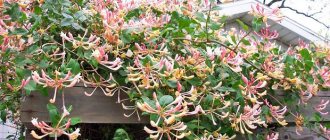Develops slowly. It begins flowering in May and pleases with bell-shaped flowers until September. Hot and humid Colombia is considered the homeland of the hirita. In nature, the plant is distributed in India, Southeast Asia, and on the rocky slopes of the Malay Peninsula.
Also see how to grow Smithianta and Achimenes.
| The intensity of development is slow. |
| Blooms from late spring to early autumn. |
| The plant is easy to grow. Suitable for a beginner. |
| Perennial. |
Hirita: care at home. Briefly
In order for the plant to always have elastic, beautiful leaves and flowers to appear on time, at home, chiryta requires careful care. The optimal conditions for keeping chiryta are as follows:
| Temperature | In winter – not lower than +15°C; in summer from +18°C. |
| Air humidity | About 50%. |
| Lighting | Scattered bright. |
| Watering | Moderate; During flowering, increase the frequency of watering; in winter, reduce it. |
| Soil for homalomena | Ready soil for Saintpaulias; a soil mixture of two parts of leaf soil and one part of peat, humus, and sand. |
| Feeding and fertilizer | From mid-March to early September - once a month with Saintpaulia fertilizer diluted by half. |
| Homalomena transplant | After the end of the first flowering; mature bushes rejuvenate. |
| Reproduction | Leaf cuttings, seeds, cuttings. |
| Features of cultivation | Periodically, use a silky brush to clean the leaves from dust. Hirita loves fresh air and ventilation. Reacts poorly to drafts, tobacco smoke and gas combustion products. Dry inflorescences and yellowed leaves should be removed in time. |
Hirita brings peace and joy to the home. Velvety leaves of beautiful colors and cheerful bells of flowers evoke a feeling of homely warmth and comfort.
General information
Khirits inhabit slopes and cliffs with calcareous soil. Often the roots of a plant develop in small cracks where there is very little space and still thrive.
The botanist David Don first described this plant in 1822, but it did not become widespread as a houseplant. Apparently, the modest, delicate bells of the hirita did not seem like an exotic flower from distant countries to lovers of indoor flowers of that time. However, in the 20th century, breeding scientists became interested in chirites, and currently there are hybrid forms of this plant with different colors and shapes of flowers and leaves.
The genus Chirits is divided into three main classes - Chirits, Microchirits and Gibbosaccus. The last ones on this list are widely used as indoor plants. Gibbosaccus have a compact bush shape like that of indoor violets. The flowers of the plant resemble the shape of a bell and rise above the foliage on thin, strong stems, forming a flower cap. Bells come in pink, white, yellow, and lilac. Chirita leaves can have different shapes, be smooth and pubescent, green and multi-colored.
Juniper essential oil (juniper oil) || Juniper oil
Hirita: care at home. Details
Hirita is an elegant, delicate plant similar to a violet. In order for the shrub to develop consistently and delight with flowering, a favorable environment is created around it.
Chyrita flowering
In mid-May, the chirita usually begins to bloom, causing delight in everyone who observes it.
By this time, the plant has formed up to five pairs of leaves. Peduncles are formed in their axils. On one long peduncle, up to 10 buds appear, collected in racemose inflorescences. They rise with a beautiful lush “cap” above emerald velvety or variegated leaves. The flowers, shaped like bells, have an elongated tubular base. They can be painted in white, cream, lilac, blue, pink shades. The lower petals of some types of chirita are marked with contrasting stripes. Each flower lives from one to two weeks. After flowering ends, a fruit is formed - a capsule with small seeds.
Temperature
Having southern roots, at home, chirita continues to be a heat-loving plant. When growing it, it is important to maintain temperature conditions. In summer, the bush is comfortable at +18 – 25°C.
In winter, the temperature should remain between + 15 – 20°C.
At higher or lower levels, the plant stops development. At temperatures below + 15°C, remove the flowerpot from the windowsill or place a wooden or cork stand under it to remove the roots from the cold surface.
Spraying
The plant does not have any special requirements for air humidity. An average degree of humidity is considered optimal for it. Therefore, spraying, according to the rules for caring for chirita at home, is not a mandatory procedure.
It can harm the plant: spots will appear on the leaves and flowers, and rot will develop. On especially hot days, you can spray the air around the hirita, trying not to touch the bush itself. It is best to place the container with the flower on a tray with wet expanded clay.
Lighting
Light is very important for the harmonious development of hyrita. If there is not enough light, the plant will not bloom. In bright light, the leaves of the chirita begin to curl and turn yellow. You can place a pot of homemade chirita in any part of the apartment.
At the same time, we must remember that if you place a flower in the northern part of the house, where there is never a lot of light, you need to turn on the backlight. In the southern part, where, on the contrary, there is very bright sun, the plant is shaded.
Watering khirita
You should be very careful when watering khirita.
It is necessary to water when the plant needs moisture (this can be seen from the drying soil). Excess moisture leads to rotting of the roots. Khirita will withstand a slight drought. But if the dry period is prolonged, it is necessary to water carefully, gradually adding small portions of water over several days. For irrigation, take well-settled lukewarm water.
Hirita pot
A large pot is not needed for khirita: it will not bloom in it. First, plant the plant in a small container. Then select a low flowerpot, the diameter of which is less than the diameter of the leaf rosette of the bush.
The diameter and height of the container for an adult plant should be approximately equal.
Priming
Khirite requires loose, breathable soil that has a slightly acidic reaction. Soil is often used for Saintpaulias, a related plant. At home, khirita can be planted in a substrate prepared from two portions of leaf soil and humus, sand and peat, taken in one portion each. To enhance drainage properties, add brick chips, vermiculite, and pieces of sphagnum.
Feeding and fertilizer
For hirita, fertilizers and fertilizing are important during the period of active growth. From the onset of spring until the last days of summer, it is fed with a diluted product for Saintpaulia. Having removed the baby from the mother plant, it is fed for six months with a preparation containing large quantities of nitrogen.
At the age of 6–8 months, phosphorus and potassium are added to the nitrogen. Next, the amount of nitrogen is minimized, and potassium and phosphorus are increased so that flower buds are formed. After the procedure, the hirita is shaded.
Transfer
The plant is replanted after the first flowering.
Annual replanting of the hirite is not required: with age, the bush stops blooming and its lower leaves fall off. Adult chirita is rejuvenated using cuttings. The young plant is planted in the smallest pot, then it is replaced with a larger one. When replanting, do not deepen the growing point. 15 days after transplantation, the hirita begins to be fed.
Pruning khirita
Hirita does not respond well to pruning. Therefore, it cannot be trimmed often. At the very beginning of spring or at the end of autumn (before or after flowering), yellowed leaves and dry pedicels are cut off. During the procedure, care is taken not to damage fragile shoots and leaf petioles.
Rest period
In hirita, the rest period is not clearly expressed. When in winter it is rarely watered, not fed and kept at a temperature no higher than + 15°C, the plant is considered to be resting. At this time, the growth of chyrite stops and there is no flowering. If the temperature in the room cannot be reduced, you need to turn on the backlight. With additional light for 13 hours a day, chirita continues to bloom.
Unconventional beauty of a rare beauty
The beauty of primulina is just beginning to be discovered, but the popularity of the plant that deserves it is still out of the question. Until recently, spirulina could only be found on the list of promising, but almost unknown and rare species. And even though she is mentioned only in the list of new trends and exotics, today many already call her the most unpretentious, magnificent and incomparable indoor baby. And although the name “primulina” is not yet known to everyone, those who have already discovered at least one of these plants or seen it at exhibitions will forever remain among the devoted fans of these flowering fairies. There are hundreds of stories about how people fall in love with primulinas at first sight and return home with a whole collection.
Primulina (Primulina) represent in indoor culture a group of rare southeastern exotics found in nature only in Asia. Even today, new species of these beauties continue to be discovered in the mountainous areas of China, Malaysia, Sri Lanka and India, although most primulinas came to us from China and Thailand. They belong to the Gesneriev family.
Primulina were introduced into culture just a little over two decades ago, and a change in their classification a few years ago was perceived as a real revolution in botany. And it is not surprising: as a result of modern research, the monospecific genus Primulin has been replenished with more than a hundred species, which were known to everyone as Chiritas. The beloved name is still used for primulinas today, often calling them primulina-chirits and even chirits. But no matter what you call these amazing little ones, they are still special plants and easily recognizable even despite their great diversity.
The amazingly beautiful rosette of primulina leaves is often compared to Uzambara violets, but such a comparison is only appropriate in terms of size and general type of development. In fact, primulina is not at all similar to violets; in many species and varieties the leaves are radically different (although there are also primulinas that from afar can be mistaken for Saintpaulia). This is a plant with a unique symmetrical arrangement of leaves, which are almost always arranged in ideal opposite pairs, each leaf having its own “opposite”. Thanks to this symmetry, the rosette looks strikingly elegant and solemn, and the plant itself is perceived as a small miracle.
The rosettes of most plants are stemless; in some species a stem is formed, but it is shortened. Primulines constantly grow in width; in some varieties and species, the rosettes can reach up to 40 cm in diameter. Some species produce lateral plants, creating unique tiers. But you shouldn’t be afraid that with age, primulina will become sloppy or deformed: even large plants retain their symmetrical beauty, and a fairly large selection of primulina allows you to choose a plant to suit your taste - from large rosettes to miniature dwarf-sized crumbs. Primulina reach only 20 cm in height, and many plants are limited to much more modest parameters.
Primulina leaves rarely resemble Saintpaulia. Oppositely located, on short or medium petioles, they can be either slightly pubescent and glossy, or densely hairy and velvety. Linear, ovoid, spatulate, rhombic, tongue-shaped or rounded shape varies depending on the variety and species. Most primulinas have foliage decorated with silver or light veins and stripes. It is believed that the beauty of the patterns on the leaves of primulina cannot be conveyed by photography: the light stripes and cushion shine, looking in person like flowing silver spilled over the leaves. These effects are somewhat reminiscent of precious orchids.
Primulina dryas 'Hisako'. © Al
The flowering of primulina in its grace will compete with orchids, although there is no talk of the same complex shapes and structure. The flowers of this plant are often compared to gentians or gloxinias. White or light pastel tubular flowers with a narrow tube, five-petaled and asymmetrical throat are decorated with contrasting dark purple or lilac stripes. The inflorescences on high peduncles, always rising above the leaves, are racemose, loose, they bear from 3 to 7 flowers. Flowers in inflorescences are also arranged symmetrically and sparsely, which only emphasizes the beauty of individual graceful “gramophones”.
The color palette of primulina is not limited only to basic, specific white and lilac tones. Thanks to active selection and breeding of varieties, as well as the constant addition to the list of species, possible color variations include pink, white, yellow, blue, indigo and lilac shades. The base color is almost always soft, light and pastel. But the veins are brighter and more contrasting.
And the most amazing thing is that with all this grace, primulina can also boast of long-flowering even with phalaenopsis. The plant blooms almost continuously, with the exception of a fairly short dormant period. Species primulinas usually bloom in summer; in winter they continue to bloom only when illuminated. Varietal flowers bloom almost all year round, with the exception of the winter dormant period.
Hirita Reproduction
At home, hirita can be propagated in different ways. Three of them are especially popular:
Growing chirita from seeds
Small seeds are sown on moist soil without deepening or sprinkling with soil. Cover with film and leave to germinate at + 23°C, periodically ventilating and spraying the soil. In about two weeks the seeds will germinate.
With additional lighting they are grown. When two leaves appear, they dive into separate pots. This is how annual species reproduce.
When sown in spring, they bloom the following winter.
Propagation of chirita by cuttings
Cut off the cuttings. Remove the lower leaves and sprinkle the cut areas with charcoal powder. The cuttings can be rooted in damp moss or water. You can immediately plant it in moist soil, cover it with film and continue to grow it in greenhouse conditions. It is best to carry out cuttings in early April so that the bush blooms next winter.
Propagation of chirita by leaf cuttings
Select a beautiful healthy leaf from the middle of the bush. Cut off from the stem with a razor. The cut is slightly dried and treated with a fungicide. To prevent the leaf itself from growing and delaying rooting, you can cut off its upper part.
Leaf cuttings are planted in peat tablets or in the ground. Can be rooted in water. When planting in the ground, try not to bury the leaf: this way it will take root faster. Babies grow up in about 45 days. The plant obtained from the leaf blooms in about 7 to 10 months.
Varieties
Among the variety of species variations of chirit in indoor floriculture, the following varieties are most common:
- Chinese chirita (also known as silver) is a low-growing plant and usually does not exceed a height of 15 cm. It differs from other relatives in the variegated color of its leaves, combining bright green and light silver colors. All of them are collected in rosettes, each of which includes at least 10 fleshy oval petals. Soft and light hair is clearly visible on the leaf blades and stem parts. The peduncle is reddish, with inflorescences of purple flowers located on it (collected in 2-3 pieces). Under suitable growing conditions, flowering continues throughout the summer.
- Lavender hirita. It differs from the previous species primarily in its size: the plant reaches a height of 40 cm, and sometimes more. On the tall stems there are large, fleshy leaves, ovoid in shape and light green in color. In the lower part of the plant they are slightly larger than in the upper, but along the entire length of the stem they are located on different sides (opposite). The flowers of the lavender variety resemble bells because they are collected at the top of the plant and are characterized by the corresponding shape. In color, two colors are dominant - mainly violet and soft purple, sometimes with white shades. The flowering of this chirita begins with the arrival of summer and continues until October, when in place of the flowers an oblong box (5 cm in length) with fully ripened seeds inside is formed.
- Microbanana chirita is an annual plant that grows and develops very quickly. This variety has a relatively short stem and shiny core leaves covered with soft pubescence. The flowers appearing in early summer are yellow and medium in size (up to 3 cm in length), with a dark orange throat.
- Chirita Tamiana is a rosette plant with large fleshy leaves, pubescent in the upper part of the leaf blade. Peduncles grow up to 20 cm in height and form up to 5–7 bell-shaped white flowers. A characteristic feature of this particular variety is the presence of blue marks along the neck of the flowers. The flowering of khirita does not have an exact connection to the season of the year, since in this case everything depends on the level of lighting. In this regard, a pronounced period of rest may be absent.
- Double chirita is a plant with small, neatly folded oval leaves: they all sit tightly and symmetrically in rosettes. The color of the leaves is rich green, with light green veins, the surface of the leaves is velvety to the touch. The plant regularly forms daughter rosettes, due to which it acquires a multi-level appearance. No more than two snow-white flowers develop in peduncles.
Diseases and pests
If the chirita is poorly cared for, it can be attacked by pests, and diseases will make themselves felt. You can immediately find out about this by looking at the plant:
- Chyrita leaves turn yellow - if large leaves turn yellow - an irreversible physiological process; if yellowing is accompanied by rotting of the stem - excess moisture (damaged leaves are removed, it is better to replant the plant, water it on time);
- dry spots on the leaves of the chirita - a manifestation of sunburn (remove damaged leaves, shade the plant from the sun);
- hirita grows slowly - not enough light (move to a brighter place);
- stems stretch out - lack of lighting (place in a well-lit place);
- hirita leaves curl - dry air in the room (use humidifiers);
- The tips of the leaves dry out due to low air humidity (place the flowerpot with a flower on a tray with wet pebbles).
Sometimes hirita is attacked by spider mites, aphids, and whiteflies. Insecticides are used against them.
Types of homemade chirita with photos and names
There are about 100 species in the natural environment. Some of them are grown at home:
Chinese chirita, silver chirita “Chirita sinensis”
A low-growing (about 0.15 m) shrub with silver or emerald leaves, the length of which reaches 10 cm. The surface of the oval leaves is pubescent, the edges are jagged. Purple flowers are collected in large inflorescences. Brownish peduncles are covered with light hair. Flowering occurs in summer.
Chirita Tamiana “Chirita Tamiana”
The height of the bush reaches 0.1 m. It has velvety small leaves and small white flowers with purple stripes running along the neck. Blooms at any time of the year.
Chirita lavandulacea
An annual shrub with dense elliptical leaves. Veins are clearly visible on the green leaf blades. Flowers are formed in the axils of the leaves and on the tops of the shoots. White flowers are distinguished by a purple limb and a yellow throat. When illuminated, it blooms at any time.
There are many chirita hybrids. They are all attractive, but some are especially popular:
Hirita “Sweet Dreams”
A compact bush with large glossy leaves and lilac flowers with dark corollas.
Hirita “Periwinkle”
A bush with catchy lavender flowers; the upper part of the pharynx is marked with an orange spot, the lower part with yellow stripes. The leaves are narrow and dark green.
Hirita “Diana Maria”
A bush with large lilac flowers with a pinkish tint, “decorated” with golden stripes. Wide green leaves are covered with silvery spots.
Types of indoor adiantum
Adiantum Ruddy (A. raddianum) - the height of the species is about 50 cm. The petioles are almost black in color, against which the green leaves look impressive. Represented in culture by interesting varieties “Lisa”, “Fritz Luethi”, “Elegans” with reddish shoots, “Fragrans” with large rounded leaves.
Maidenhair (A. tenerum) is a large fern native to the islands of Indonesia, which can reach up to 70 cm in height. Its long, thin petioles resemble the shoots of a weeping willow.
The low variety "Scutum Roseum" has young feathery leaves at the tips that are pink. Variety "Lady Moxam" with numerous long petioles and wavy leaves.
Variety "Lady Moxam"
Maidenhair (A. capillus veneris) is the most famous and widespread fern in floriculture, which owes its popularity to its high decorative qualities and hardiness in care.
Venus hair, like the above species, does not look like traditional ferns; its leaves resemble miniature triangles, cut along the outer edge, and the petioles are so thin and flexible that they really resemble hair.
